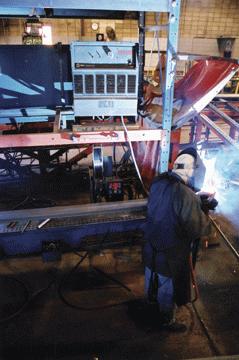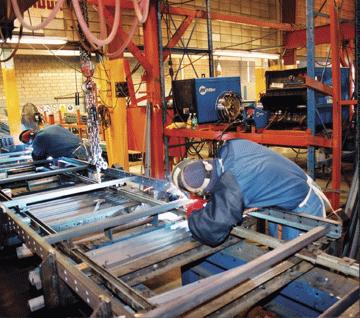Executive Summary
- Weld parameter locks helped ensure proper bead profile.
- Tight tolerances mean that operators need to stay within established parameters. Programmable feeders help maintain quality from operator to operator, shift to shift.
- S-74DX allows Frazier to store four independent sets of welding parameters.
- S-74DX weld sequence control permits operators to set gas pre-flow and post-flow times, wire feed run-in speed, weld time, crater time and wire burnback.
- Frazier achieved payback within three months through increased productivity and reduced reject rates (less than one-half of one percent).
Structural Steel Storage Rack Maker Depends on S-74DX Wire Feeder for Uniform Quality
More than a half century ago, Frazier Industrial made a commitment to using structural steel in all its products. That was in 1949, a time when structural steel cost more than inferior roll-formed products, but Frazier felt the advantages of strength and durability greatly outweighed the cost difference.
The company's strategy became known as the Frazier Difference, and it turned out to be a wise decision, both for Frazier and its customers. Based in Long Valley, N.J., Frazier has become the industry leader in the manufacture of structural steel storage racks. The firm reached that position because of its emphasis on uniform quality in every product it produces.
The storage rack industry maintains tight quality control procedures because the racks must be able to withstand a rigorous warehousing environment. In addition, Frazier does a great deal of business in the western United States, and therefore its structural steel storage racks must meet strict standards for areas of high seismic potential.
 |
The digital LED display on Miller's S-74DX wire feeder (background) shows the welding parameters as the operator uses a Deltaweld 452 power source to weld a load beam for a Frazier storage rack.
|
Frazier's 11 strategically located worldwide manufacturing plants produce a wide range of innovative structural steel rack systems and rack-supported structures for warehouse storage applications. Rack systems store everything from sofas to jet engines.
Frazier's emphasis on quality has led the company to recently upgrade to Miller's S-74DX, a semiautomatic, constant speed wire feeder with features that meet Frazier's need to maintain uniform, quality welds from operator to operator and plant to plant.
S-74DX Is a Good Fit
Aaron Evans, quality assurance manager for Frazier, says Miller's S-74DX wire feeder plays a key role in his company's quality control program.
"We run the same welding parameters in every single one of our plants to ensure uniform quality and consistency, no matter where the component is made," Evans says. "Our procedures are such that we need to control both the width and the penetration of the bead so that we get good tie-in on both plates involved with the weld. The reason we use the Miller wire feeders is because they help us control part of that process."
Miller's S-74DX suits Frazier's needs just fine. "I went to Miller a few years ago and saw the top-of-the-line 60M feeder and I said, 'Look, we don't need all the bells and whistles. What we need is a stripped down version of a programmable feeder.' And that's just what they came up with," Evans says. The S-74DX offers some of the same capabilities as the 60M wire feeder, such as an adjustable weld sequence control to help maintain weld consistency and quality between shifts and operators, but without an extremely sophisticated pulsing control. And it's priced one-third less than the high-end pulsing feeder.
The S-74DX is a perfect fit for manufacturers that want the simplicity of a standard feeder and the programmability benefits of the 60M.
 |
|
Work progresses on a load beam for a Frazier Industrial storage rack.
|
For example, the S-74DX's weld sequence control permits setting gas pre-flow and post-flow time, wire feed run-in speed, weld time, crater time and wire burnback. Adjusting parameters such as run-in speed can improve arc starts, while crater control helps the operator prevent crater cracking at the end of the weld.
With four weld programs, the S-74DX allows operators to store customized weld parameters, which reduces setup time when operators regularly switch between two different applications.
The S-74DX runs hard and cored wires from .023 to 1/8 inch diameters, and has a wirefeed speed range of 50 to 780 IPM. The feeder has a spool size capacity of 60 lb. and incorporates Miller's unique Posifeed four-drive-roll system that features all-gear-driven drive-roll carriers that grip wire more positively than a single-driven wheel/idler wheel arrangement. A solid-state speed control and brake circuit provide excellent speed control and wire regulation, as well as increased service life over systems with electrical/mechanical relays.
Set and Lock Parameters
For Frazier's purposes, the key feature of the S-74DX is its weld process control feature that sets and locks in welding parameters to ensure operators consistently weld within specifications, yet still offers them limited freedom to tailor wire feed speed and voltage values to suit their personal tastes. And the S-74DX features easy-to-read digital LED displays.
"Our tolerances are tighter than American Welding Society standards. We need to ensure that operators stay within our established parameters and the S-74DX helps maintain weld quality from operator to operator and shift to shift," Evans says. "Because we build products used in areas that have concerns about seismic occurrences, welding quality is very critical. We absolutely have to maintain our welding parameters. If we don't, we'll pay the price later."
And no one wants to pay the price later, both for monetary and customer satisfaction reasons.
 |
|
Operators for Frazier Industrial weld cross beam sections for the company's storage rack systems. The welds have tight tolerances because they must meet strict standards for high seismic areas.
|
"When setting up for a component, operators can refer to our quality assurance manual and the parameters they're allowed to run. Now, if they don't follow every single one of the items on that sheet, then they're outside of the established procedures. That's why every one of the parameters can be controlled, and we want the machines to control all of the very critical ones, such as wire speed, voltage and gas flow. The rest of it is done by the operators," Evans says.
A welding engineer or supervisor sets voltage, gas flow and wire speed feed to the specified parameters, which are accurately displayed on the feeder's digital display. Then he can lock in those values to within 5, 10,15 or 20 percent of the specifications. This ensures that operators consistently weld within the established parameters. For the racking industry, code is 10 percent of specifications, but Frazier locks in at significantly less than that.
Quick Return on Investment
Another reason for going with the S-74DX is its impressive return on investment track record. According to Evans, "The difference between this feeder and a regular feeder is about $600. I can pay for this feeder in less than three months. Here's how. Normally, you would have to calibrate the equipment at the beginning of every shift. So, if the operator has to sit here and time his wire and check his voltage every day that takes 10 minutes a day, 10 minutes a shift. That's 10 minutes of lost production per machine.
"Figure it out. We have 24 Miller welding machines at this plant. That's 240 minutes. Now, 240 minutes of building product instead of calibrating the equipment means it takes less than three months to make that $600 back. And there's a second savings. I don't have to have an inspector focused on verifying that every machine is set to the proper parameters each morning. Every operator in the plant is trained to do that and they still have to do it once a week, just to make sure that nothing is wrong with the machine," Evans says.
Another major cost savings results from fewer welds being rejected during final inspection. "Inspecting product after it's built is too late from the standpoint that the damage is already done and rework costs time and money. In a high-speed production environment, you can pretty much control your destiny with the equipment you choose. You can either build a lot of high-grade quality product, or you can build a lot of garbage in a hurry," Evans says.
Frazier uses about 50 to 60 Miller power GMAW sources - including the Deltaweld 452 - because of their reliability, and Miller's responsiveness to customer needs. "We've had these machines here for about five years, and in all that time we've had one transformer go out in one machine. Miller picked it up, repaired it and brought it back. That's good service and that's why we buy their product. I like Miller equipment because I rarely have to put any money into it. That's a good piece of equipment," Evans says.
"Customer service is a big issue with me. If I call my Miller rep, he gets back to me within two hours - always. If I need units the next day, they're drop-shipped somewhere. And that's how quick we can get them," Evans says.
And for a company that has built its reputation on using quality materials to provide its customers with top-quality products, Frazier appreciates being on the receiving end of that type of commitment in its dealings with Miller Electric.